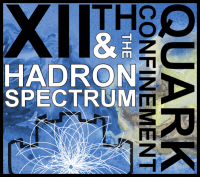Speaker
Description
Our formalism is based on the Covariant Spectator Theory (CST), a framework based on field theory originally developed to study systems of few nucleons. The distinctive feature of this approach is that it approximates the full Bethe-Salpeter-equation by taking into account, effectively, the contributions of both ladder and crossed ladder diagrams in the kernel.
Another notable feature of the CST equations is that they are established in physical Minkowski space. Therefore, the results obtained are not restricted to bound state masses and momentum regions which are free of propagator singularities. This is advantageous over Euclidean formulations (although it entails the difficulty of handling those singularities numerically) because form factors can be computed directly in the timelike region with no need for analytical continuations.
To model phenomenologically the interquark interaction, we adopt a kernel compatible with the requirements of chiral symmetry that contains a linear confining term, a color Coulomb term and a constant. This choice allow us to have a straightforward correspondence with the Cornell potential (plus a constant) and recover, in the nonrelativistic limit, the results from the Schrödinger equation. The parameters that characterize this model, namely the constituent quark masses and coupling constants, are fitted to data and compared with their counterparts provided by other approaches such as lattice QCD and formulations based on the Dyson-Schwinger equations.
Summary
In this work we compute a variety of $q\bar{q}$ mass spectra, ranging from heavy to heavy-light sectors, using a unified and manifestly covariant relativistic description. Calculations for mesons with different tensor structures are performed and compared with experiment, as well as with the result of other approaches.




